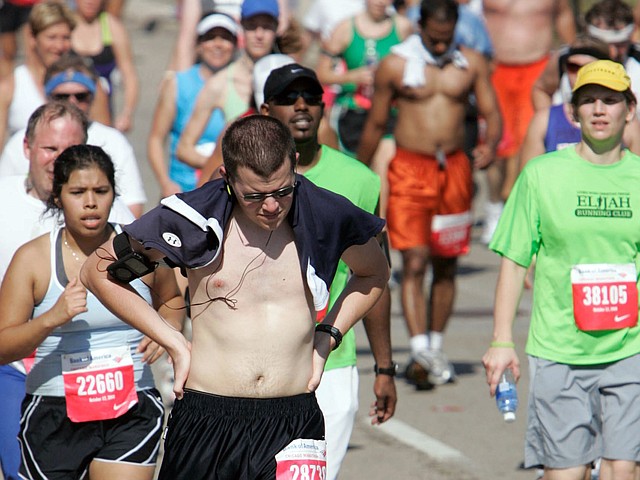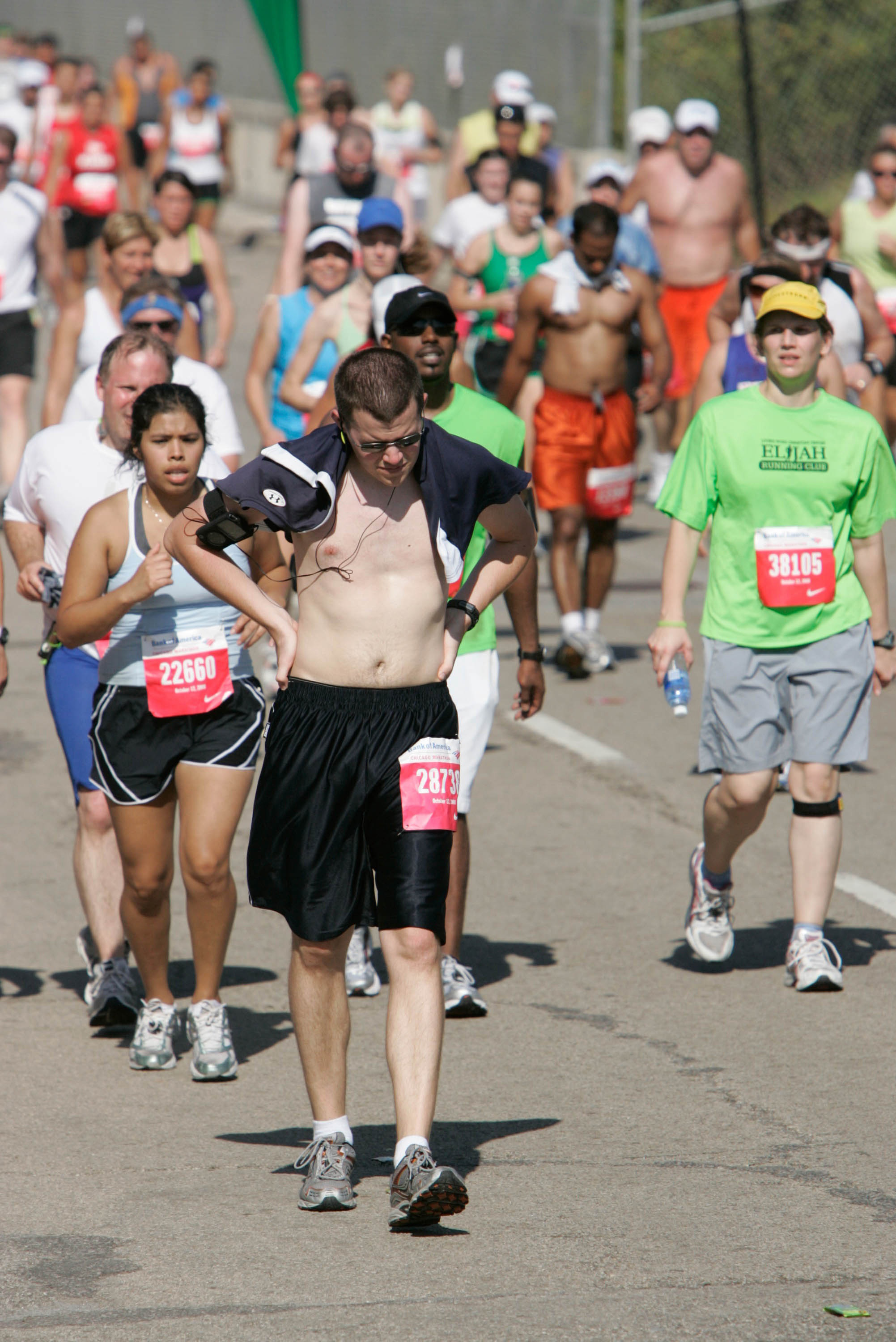Experts say getting your 'second wind' is a real phenomenon
Friday, January 1, 1904
SECOND WIND TERMS• Glycogen -- A carbohydrate that serves as the body's primary energy source. During exercise, it initially is drawn from muscles and later from the liver.• Metabolism -- The body's process for breaking down stored fuel, such as glycogen and fatty acids, into useable energy.• Hitting the wall -- The point of extreme fatigue caused by complete depletion of glycogen stores. Usually occurs during extreme long distance runs such as marathons.• Aerobic exercise -- Activities during which oxygen intake meets the body's needs. Occurs during low-intensity, long-term exercises such as distance running, swimming and cycling.• Anaerobic exercise -- Activities during which oxygen intake doesn't meet the body's needs and must be supplemented by metabolism of glycogen. Occurs during high-intensity, short-term activities such as sprinting or weightlifting.• Lactic acid -- A byproduct of anaerobic metabolism. Its buildup can impede muscle function and results in the uncomfortable burning sensation in muscles.• Homeostasis -- The tendency of the body to achieve a state of equilibrium, as when metabolic rate and breathing level off after meeting the needs of vigorous exercise.• Steady-state exercise -- Exercise performed at low enough intensity to be sustained for a prolonged period as opposed to alternating between high- and low-intensity, as in interval training.• Oxygen debt -- The cause of heavy breathing resulting from vigorous exercise as the body seeks to take in enough oxygen to restore its systems and fuel metabolism.
Runners describe the feeling of a second wind as one of increased confidence, improved performance and less-strenuous breathing, often just as they were starting to feel overwhelmed by fatigue.
The only problem with second winds, runners said, is they never know when to expect them.
Some said they experience the feeling 10-15 minutes into a run, others only after covering five miles or more. Even when running the same distance under the same conditions, however, a second wind's appearance can be as unreliable as the light from a bulb with a short.
"Sometimes, you'll never feel that, and sometimes you do," said Joey Howe, 48, a lifelong runner and general manager of the Cherokee Boulevard running supply store Fast Break.
"It's really an unknown," he continued. "It's not something I feel every time. It's not even something I can say I feel even half the time."
When it occurs, however, the sensation can be a godsend, said Chattanooga Track Club president Bill Moran, 60.
"To me, it just feels like you have something left in your tank," he said. "It's a confidence that, between your energy stores and your respiration, you feel like you can finish.
"Your body is telling your mind, 'I can do this.' "
An estimated 20,000 participants in the Boston Marathon on Monday wouldn't have turned one down, but even joggers say they can be an unexpected blessing.
To runners, a seemingly inexplicable sense of renewed energy during long races can be hugely motivating, even if they don't know what causes the sensation.
The first time 25-year-old Chattanooga Track Club president-elect Chas Webb experienced a second wind, he was more confused than grateful.
"I didn't understand what was going on," he said, laughing. "I had been running for 40 minutes or so. Normally, that point is when I stop, but I wanted to keep going. You start to question if you're pushing yourself hard enough."
A mystery explained
Although the second wind has not been studied extensively, exercise physiologists said the condition is not as mysterious as it appears.
Some scientists link the positive feelings of the second wind to the release of pain- and stress-relieving endorphins from the pituitary gland, but the cause may be even simpler, said Dr. Burch Oglesby, an associate professor in the health and human performance department of the University of Tennessee at Chattanooga.
The second wind could be the result of the body achieving a state of equilibrium, at which muscles are at optimal temperature (slightly higher than 98.6 degrees) and the body's oxygen needs are sufficient to meet the demands of a runner's pace.
When the body properly regulates respiration to meet the long-term demands of steady-state exercise, muscles begin operating more efficiently, breathing evens out and fatigue is decreased compared to earlier in the run, resulting in the sensation of a second wind.
The process is something like the body's equivalent of balancing its budget, Dr. Oglesby said.
"When that plateau or homeostasis is achieved, you've paid the oxygen debt off, unless you increase the pace," he said. "The bottom line is, it's a state of equilibrium that occurs between what the debt is and the payment of that date."
Dr. Oglesby said the sensation is generally achieved as a result of conditioning, which causes the muscles to become more efficient and the heart to undergo changes that increase blood flow.
Rules and regulations
As the body learns how best to regulate itself to met the rigors of a runner's pace, the chances of getting a second wind becomes more likely, physiologists said.
A proper pre-workout warm up or walking and then slowly jogging before reaching race pace helps the muscles warm to their most efficient temperature, a few tenths of a degree above core temperature, Dr. Oglesby said.
During a run, a second wind can sometimes occur by slowing temporarily to below race pace. This gives the body and its hormones a chance to recover by paying off some of its oxygen debt.
Those new to running may not experience the sensation at first because they constantly over-exert themselves, incurring more oxygen debt than they can pay off, said UTC health and human performance professor Dr. Nicholas Boer.
Nevertheless, conditioned athletes are the ones who should need to rely on a second wind the least, Dr. Boer said.
"The key is to use sound training principles to start with, and then hopefully you don't need it," he said. "If you start at a reasonable pace and work from there, you'll probably be all right."
Even though Webb enjoyed the experience of his first second wind, he said he can't depend on the aid of something so unpredictable to get him through a run, even if it's nice to have the help on occasion.
"I can't say to myself, 'OK, if I keep going, something will happen,' " Webb said. "If you're running for the point of getting one, you probably won't get one, [but] it is a nice reward."
This article was edited on April 20, 2012. Chattanooga Track Club president-elect Chas Webb was misidentified.

